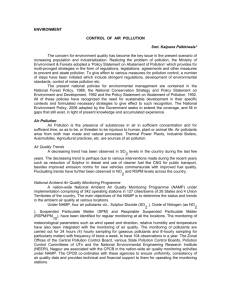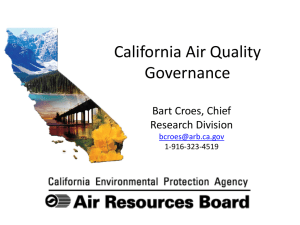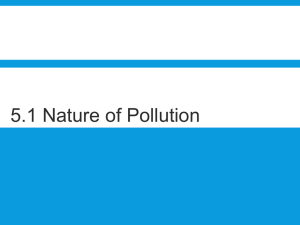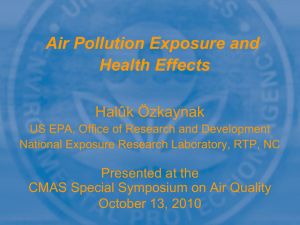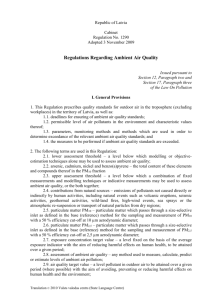Presnt-SERB-AQSC-2012
advertisement
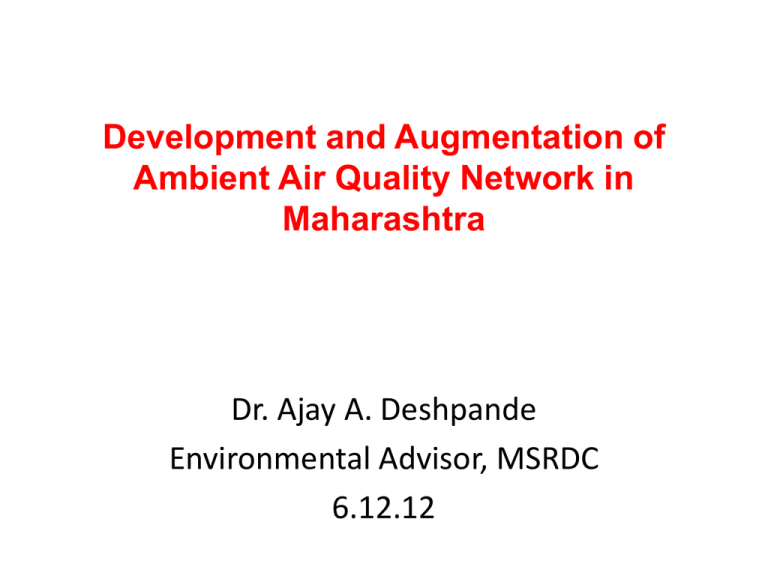
Development and Augmentation of Ambient Air Quality Network in Maharashtra Dr. Ajay A. Deshpande Environmental Advisor, MSRDC 6.12.12 Legislative Framework • Air (Prevention and Control of Pollution) Act, 1981 • Environment (Protection) Act, 1986 • Smoke Nuisance Acts • CPCB and SPCB are the field level institutions responsible for enforcement and compliance • MOEF/CPCB provides the policy framework Functions of CPCB 16. (1) the main functions of the Central Board shall be to improve the quality of air and to prevent, Control or abate air pollution in the country . (2) In particular and without prejudice to the generality of the foregoing functions, CPCB may•(a) advise the Central Government on any matter concerning the improvement of the quality of air and the prevention, control or abatement of air pollution; •(b) plan and cause to be executed a nation-wide program for the prevention, control or abatement of air pollution; •(c) co-ordinate the activities of the State and resolve disputes among them; •(d) provide technical assistance and guidance to the State Boards, carry out and sponsor investigations and research •(e) plan and organize the training of persons engaged or to be engaged in program •f) organise through mass media a comprehensive program g) collect, compile and publish technical and statistical data relating to air pollution and the measures devised for its effective prevention, control or abatement and prepare manuals, codes or guides h)lay down standards for the quality of air, •I) collect and disseminate information in respect of matters relating to air pollution; Functions of SPCB 17. (1) the functions of a State Board shall be(a) to plan a comprehensive program for the prevention, control or abatement of air pollution and to secure the execution thereof; (b) to advise the State Government on any matter concerning the prevention, control or abatement of air pollution; (c) to collect and disseminate information relating to air pollution: (d) to collaborate with the Central Board in organising the training of and to organise mass-education Program relating thereto; (f) to inspect air pollution control areas at such intervals as it may think necessary, assess the quality of air therein and-take step for the prevention, control or abatement of air pollution in such areas; (g) to lay down, in consultation with the Central Board and' having regard to the standards for the quality of air laid down by the Central Board standards, for emission of air pollutants into the atmosphere from industrial plants and automobiles or for the discharge of any air pollutant into the " atmosphere from any other source whatsoever not being a ship or an aircraft: Objectives of Ambient Air Monitoring • To determine status and trend in ambient air quality and effects of air pollution in urban environment • To ascertain whether the prescribed ambient air quality standards are violated and to assess health hazard, damage to materials • To obtain the knowledge and understanding necessary for developing preventive and corrective measures. • To understand the natural cleansing process undergoing in the environment through pollution dilution, dispersion, wind based movement, dry deposition, precipitation and chemical transformation of pollutants generated. Design of Monitoring Network • Neighborhood Scale– Monitoring represents ~500m – 4 km – Used to see effect of local sources, traffic etc • Urban scale – -Monitoring represents ~ 4- 100 km – Located at higher elevations away from roads, industries etc. – Represent mixture of various sources within an urban complex • Regional Scale – Monitoring represents ~ 100-1000 km – Located away from sources in rural areas and located at much higher elevations NAMP • Central Pollution Control Board is executing a nation-wide program of ambient air quality monitoring known as National Air Quality Monitoring Program (NAMP). • The network consists of 342 operating stations covering 127 cities/towns in 26 states and four 4 Union Territories of the country. • CPCB mentions that this is a compliance monitoring and these data be treated as indicative rather than absolute. NAMP-Details • Four air pollutants viz ., Sulphur Dioxide (SO2), Oxides of Nitrogen as NO2, Suspended Particulate Matter (SPM) and Respirable Suspended Particulate Matter (RSPM / PM10) monitored regularly. • The monitoring of meteorological parameters such as wind speed and wind direction, relative humidity (RH) and temperature were also integrated with the monitoring of air quality. • Monitoring is carried out for 24 hours (4-hourly sampling for gaseous pollutants and 8-hourly sampling for particulate matter) with a frequency of twice a week, to have one hundred and four (104) observations in a year QA/QC • • • • Visit to Monitoring Stations Review Meetings Analytical Quality Control Training Program on Ambient Air Quality Monitoring • Guidelines for Ambient Air Quality Monitoring • Calibration, Repair of Instruments and Evaluation of Ambient Air Quality Monitoring Stations MPCB INITIATIVES: A Case Study • Responsibility of operation of ambient air quality monitoring in the state. Operation of NAMP stations was taken over from CPCB wef 1.7.05. • Prepared road map for developing the ambient air quality network in the state. • Developed partnership with educational institutions for engaging them in AAQM. • Display of ambient air quality in major cities on daily basis in media and website. Continued…. • Audit of all existing NAMP stations and operationlize them with necessary financial support. • Developed a PPP document with suitable financial proposal to achieve reliable AAQM • Procurement of new instruments • Monitoring primarily for RSPM, NOx and SO2 • Proposal for complimentary health study • Analysis and interpretation of data for trend analysis and attempt to link it to inventory • Use of data for policy inputs (green tax, industry location ) and also development of Action plans Continued…. • Operationising the existing CAAQMS through PPP on a long term basis. • Procurement of new CAAQMS for cities of Pune, Solapur and Mumbai • Audit and calibration of all CAAQMS with private sector to ensure the efficient data collection. • Major industries like thermal power, steel, cment, fertilizer, refinery are asked to install CAAQMS for data sharing and display. • Proposal developed for rationalization of large numbers of CAAQMS in Chembur area of Mumbai over the entire city. OPTIMISATION TECHNIQUES • All cities having municipal corporations (more than 0.5 million population) to be covered. • All important industrial areas to be covered • AQN developed for multiple pollutants • Optimization designed on index theory based on available AQ data. • AQN designed to have sound combination of manual (twice in week and daily monitoring) and CAAQMS . • AQN to represent residential, traffic and industrial areas MPCB Environmental Monitoring: AIR Ambient air quality Monitoring stations Year NAMP SAMP CAAQMS 2004-05 5 - 3 2005-06 28 5 3 2006-07 45 10 3 2007-08 45 9 6+1 NMMC 2008-09 53 15 6+2 NMMC 2009-10 56 12 6+2 NMMC 20010-11 65 12 6+2 NMMC •PM 2.5 monitoring and its chemical characterization initiated in 2007-08. •VOC monitoring at industrial areas of Taloja & Mahad in February, 2009. • @ 55 major Industrial units have now installed CAAQMS with display system. PAMS Concentration of SO2 in µg/m3 Trend in Annual Average Concentration of SO2 2005-2009 60 50 40 30 20 10 2005 0 M umbai T hane Aur angab Chandr ap ad ur Kal yan Kol hapur Nagpur Navi Sol apur T ar apur Lote Pune Nashi k M umbai Ul has Jal na Amr avati Latur Sangl i Roha M ahad Jal gaon 2006 Nagar 2005 25 5 10 24 37 8 13 0 18 0 0 23 32 0 0 0 0 0 0 0 0 2006 36 11 7 25 25 8 10 32 17 20 26 25 29 24 12 12 0 0 0 0 0 2007 27 13 8 36 31 7 10 23 16 24 19 21 37 30 23 11 0 0 0 0 0 2008 34 12 11 34 38 12 10 20 17 30 25 23 27 28 26 10 4 27 0 0 0 2009 25 13 7 35 0 12 11 18 18 0 0 21 24 53 17 11 6 25 12 12 13 City 2007 2008 2009 PAMS Concentration of NOx in ug/m3 Trend in Annual Average Concentration of NOx 2005-2009 100 80 2005 60 2006 Standard 2007 40 2008 2009 20 0 Mu A ur C ha N avi U lha A mr Tha Kaly Kolh N ag Sola Tara Pun N as Jaln Lat u San R oh M ah Jalg mba ang ndra Mu Lot e s avat ne an apur pur pur pur e hik a r gli a ad aon i aba pur mba N ag i 2005 76 10 25 34 44 25 33 0 39 0 0 37 30 0 0 0 0 0 0 0 0 2006 77 11 20 31 52 26 27 38 36 24 10 42 27 38 19 18 0 0 0 0 0 2007 75 11 21 42 35 17 25 34 32 31 21 46 33 43 37 13 0 0 0 0 0 2008 86 16 21 48 56 20 28 42 34 52 27 39 26 50 42 13 18 19 0 0 0 2009 62 20 25 29 0 15 32 48 36 0 0 38 30 92 31 14 23 28 28 33 45 City Concentration of RSPM in µg/m3 PAMS Trend in Annual Average Concentration of RSPM (dust) 2005-2009 250 200 150 100 Standard 60ug/m3 50 0 Mumb ai Thane Auran Chand Kalya Kolha Nagpu gabad rapur n pur r Navi Mumb ai Solap Tarap ur ur Lote Pune Nashik Ulhas Nagar Jalna Amrav ati Latur Sangli Roha Mahad Jalgao n 2005 2005 180 50 92 124 96 68 47 0 127 0 0 124 92 0 0 0 0 0 0 0 0 2006 2006 220 53 84 116 95 70 57 83 107 77 68 130 76 146 82 57 0 0 0 0 0 2007 2007 194 54 77 161 105 67 112 94 85 84 78 108 61 102 101 62 0 0 0 0 0 2008 202 58 82 172 101 82 108 130 88 79 76 103 90 88 144 67 86 51 0 0 0 2009 146 59 85 108 0 82 103 105 71 0 0 87 84 100 105 89 114 59 107 153 107 City 2008 2009 Revised NAAQS 2009 • National Ambient Air Quality Standards (NAAQS) have been revised Vide MoEF Notification dated 16.11.2009. • The Notification has included parameters like Ozone, Benzene, Benzo(a) Pyrene, PM 2.5 & Metals like Arsenic, Nickel and, SPM is removed. • Industrial& Residential categories are clubbed together & standards are made more stringent. • Implementation of the notification necessitates modifications in infrastructure, expertise & cost. New parameters (brief) Unit PM2.5 µg/m3 Limit 60 24 hr Ozone O3 µg/m3 180 1 hr Ammonia NH3 µg/m3 400 24 hr Benzene C6H6 µg/m3 5 Annual Benzo(a)Pyrene BaP ng/m3 1 Annual Arsenic As ng/m3 6 Annual Nickel Ni ng/m3 20 Annual Major changes / additions • Addition of 7 more parameters to the existing 5 parameters • Sensitivity up to nano-gm/m3 • PM2.5 requires separate instrument • Duration in sampling & analysis reduced posing more limitations on storage & transportation of samples Comparative Statement of Existing & Revised Standards Sr.N o. Pollutant Time Weighted Average Existing Standards Revised Standards Conc. In ambient air Industrial areas Residential, Rural & other areas Methods of Measurement Conc. In ambient air Sensitive areas Industrial, Residential, Rural & other areas Ecologically sensitive area(notifie d by Central Govt.) 1 Sulphur dioxide (SO2) µg/m3 Annual 24 hours 80 120 60 80 15 30 50 80 20 80 - Improved West and Geake - Ultraviolet Fluorescence 2 Nitrogen dioxide (NO2) , µg/m3 Annual 24 hours 80 120 60 80 15 30 40 80 30 80 - Jacob & Hochheiser Modified (Na-Arsenite) Method - Chemiluminescence 3 Particulate matter(size less than 10µm) or PM10, µg/m3 Annual 24 hours 120 150 60 100 50 75 60 100 60 100 -Gravimetric -TOEM -Beta attenuation 4 Particulate matter(size less than 2.5µm)orPM2.5, µg/m3 Annual 24 hours - 40 60 40 60 -Gravimetric -TOEM -Beta attenuation 5 Ozone (O3), µg/m3 8 hours 1 hour - 100 180 100 180 -UV Photometric - Chemiluminescence -Chemical Method - - - - 1.0 1.5 0.75 1.0 0.5 0.75 0.50 1.0 0.50 1.0 -AAS/ICP Method after sampling on EPM 2000 or equivalent Filter paper. - ED-XRF using Teflon filter 6 Lead(Pb), µg/m3 Annual 24 hours 7 Carbon Monoxide (CO), mg/m3 8 hours 1 hour 5.0 10.0 2.0 4.0 1.0 2.0 02 04 02 04 -Non Dispersive Infra Red (NDIR) -Spectroscopy 8 Ammonia (NH3), µg/m3 Annual 24 hours 100 400 100 400 100 400 100 400 100 400 -Chemiluminescence - Indophenol- blue method 9 Benzene (C6H6), µg/m3 Annual - - - 05 05 - Gas chromatography based continuous analyser - Adsorption and Desorption followed by GC analysis 10 Benzo(a)Pyrene(Ba P)particulate phase only, ng/m3 Annual - - - 01 01 Solvent extraction followed by GC/HPLC analysis. 11 Arsenic(As), ng/m3 Annual - - - 06 06 AAS/ICP Method after sampling on EPM 2000 or equivalent Filter paper 12 Nickel(Ni), ng/m3 Annual - - - 20 20 AAS/ICP Method after sampling on EPM 2000 or equivalent Filter paper Revised Standard - Criteria of Monitoring • Monitoring needs to be done minimum 104 measurements in a year at a particular site taken twice a week 24 hourly at uniform intervals. • 24 hourly or 8 hourly or 1 hourly monitored values, as applicable, shall be complied with 98% of the time in a year, 2% of the time, they may exceed the limits but not two consecutive days of monitoring. • Whenever and wherever monitoring results on two consecutive days of monitoring exceed the limits specified above for the respective category, it shall be considered adequate reason to institute regular or continuous and further investigation. Challenges in Implementation of Revised Standards • Most of NAMP/SAMP operating institutes do not have the required advance laboratory infrastructure. • Skilled manpower requirement • Large expenditure • Monitoring of Benzene, O3, by manual method mentioned in notification is very difficult. • Though, SPM is not included in revised standards, need to monitor in industrial area to establish corelation with PM10 and PM2.5 (Source standards are in TPM Too Many Sampling Chains! • Handling two different instruments for sampling of PM10 and PM2.5 • Metal pollutants sample source is GF filter paper • Gaseous pollutants in liquid absorbing solutions • U-Tube with dichromate paper for O3 • Organic pollutant with extra low rate sampler with media tubes Proposed Road Map • Need to operationalise the NAMP/SAMP stations as per NAAQMS 2009 • Need to ensure that the CAAQMS in industrial sector are functional continuously and correctly. • Need to initiate air quality monitoring for VOCs which have been critical parameter in deciding pollution index. • Analysis and interpretation of data for development of action plans and linkage to health studies, traffic management, source inventory etc. • Development of air quality index for dissemination of air quality data for better understanding of air quality • Promote air quality issues as Public Health Concern I would like to acknowledge MPCB, my previous organization, for the information and data in the presentation THANKS

